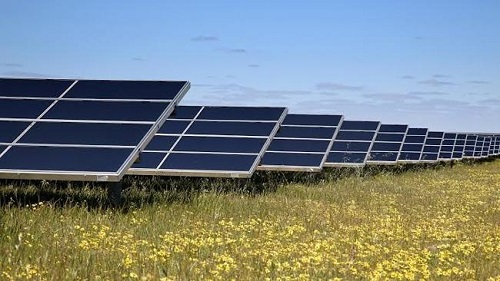Toowoomba Regional Council has approved a $1bn solar farm for a total footprint of up to 2 gigawatts over the next eight years.
APPROVAL has been given for the largest solar farm in the country — and possibly the largest proposed in the world — to be built in Queensland.
Construction on the 13,000-acre Bulli Creek site near Powerlink’s substation near Millmerran, southwest of Toowoomba, is expected to start next year. It will be on cleared, flat cattle grazing land.
Developer Solar Choice has received approval from Toowoomba Regional Council for a total footprint of up to 2 gigawatts over the next eight years.
The solar farm will be built in stages of multiple 100MW-plus phases, within a total planning approved envelope of 2GW.

If the farm reached its full potential it would take Australia 25% closer to achieving the mandated 41,000GWh target by 2020.
The ‘largest in the world’ claim relates, I think, to solar PV.
They say the project is expected to start next year but:
“The Bulli Creek project is attracting attention from a range of global investors prepared to take a medium- and long-term view,” Solar Choice said, stating it remained open to a large-scale investor.
There’s more at RenewEnergy.
Managing Director of Solar Choice, Angus Gemmell, says the Bulli Creek Solar Farm is one of a very small and select number of mega-scale solar projects that Solar Choice has strategically located at transmission nodes on broad-acre lands with high solar irradiation, west of the Great Dividing Range.
These include a 1GW solar project currently being progressed through the Whitsundays Regional Council , directly adjoining Powerlink’s 275kV Strathmore Substation at Collinsville. Another 300MW project, the Gannawarra Solar Farm in north-western Victoria, is already planning approved on the 220kV transmission lines between Swan Hill and Kerang.
“We believe that large-scale solar is on the right side of history – it’s not a matter of if these projects will be built, but when,” Gemmell told RenewEconomy in an interview.
The Toowoomba approval allows for battery storage to be added, should that become feasible.
For those who don’t know, Toowoomba at about 110,000 is the most populous inland non-capital city in the country and is the second most populous inland city overall, after Canberra.
ACT renewable energy contract
On another thread John D informed us of the ACT renewable energy contract.
The prices announced have stunned some observers, including rival bidders such as AGL Energy, which had hoped to kick-start it Silverton project. The prices are even lower than they appear, because the ACT tariff is fixed for 20 years, and it does not rise for inflation.
It appears three wind farm projects have been approved, at Bendigo ($81.50/MWh), at Ararat, west of Bendigo ($87/MWh) and at Hornsdale, south-east of Port Augusta ($92/MWh).
Battery storage
AGL Energy is planning a major new push into the rooftop solar market, along with digital meters, battery storage and home management systems.
Australia’s biggest energy utility, AGL Energy, says battery storage is already an “interesting” proposition for consumers, and it expects radical changes in the home energy market in coming years.
“We are at the point where we have got big changes going on (in energy markets),” AGL Energy managing director Michael Fraser said on Wednesday.
“We see battery storage technology going ahead in leaps and bounds.” This, in conjunction with rooftop solar and home energy management systems, would cause a “significant” and “fundamental” change in the way the energy market operates, Fraser said.
Brisbane-based Redflow says it is fast-tracking the rollout of its battery storage products to the residential and mining sector.
Redflow, which is bringing its unique zinc bromide flow battery to market, says its new products are 40 per cent cheaper than its first generation products, and are now approaching grid tariffs in some markets.
So much so, that CEO Stuart Smith says the grid, the backbone and chief source of electricity [for] more than a century, could soon be relegated to the role of mere “back-up”. This, of course, has huge implications for existing utilities – be they network operators, retailers, and/or generators.
“We believe we have a disruptive, scalable technology whose applications are continually expanding,” Smiths says.
“The future where the grid progressively becomes a backup rather than the primary source of energy is fast approaching by integrating our products with renewables such as solar and wind at a residential and commercial level.”
It seems they will be targeting Germany amongst others, where there is lots of solar and high electricity prices.
Tesla is also gearing up to enter the battery storage market. In an interesting development:
Queensland network operator Ergon Energy is installing up to one hundred 100kWh battery storage units because it is less costly than traditional grid upgrades. The units will be installed without subsidies, and other network operators are also trialling various battery storage models.
South-east Queensland is supplied by Energex. Ergon supplies the rest of the state where network costs are higher.
SA looks at nukes
South Australia has announced a Royal Commission into nuclear energy. At New Matilda, nuclear advocates Barry Brook and Ben Heard put the case in favour:
Nuclear is expensive, at least compared to coal. But when coal pays its environmental costs (especially for air pollution and greenhouse gas emissions) nuclear is not expensive at all.
Electricity from some renewables is now comparatively cheap. But when renewables pay their full system costs to overcome variability, a renewable system is very expensive indeed.
In this context, a ‘nuclear intensive’ strategy is still likely to underpin the most viable, scalable and cost-effective pathway to replace coal.
Nuclear is the safest form of large-scale energy production, when evaluated on the basis of deaths per unit of generation.
Not sure where we go with nukes, but with a bit of luck Abbott’s attempt to kill off renewables should be no more than a bump on the road in the longer term.

